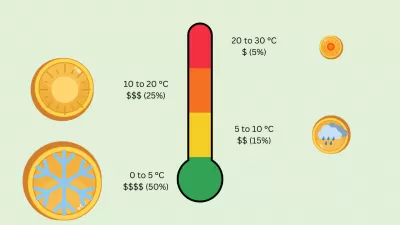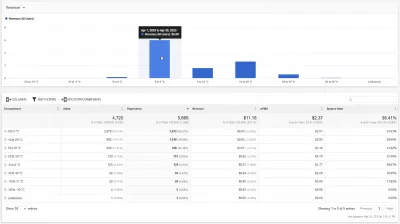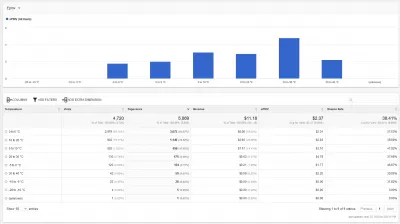Impact of Local Temperature on Website Display Advertisement Earnings
Understanding the relationship between weather conditions and website monetization is crucial for optimizing display advertisement earnings. In this article, we analyze a comprehensive chart that reveals how different temperature ranges impact visits, pageviews, revenue, ePMV, and bounce rates. Let's dive into the findings and explore the implications for website monetization strategies.
Overview of the Chart:
The chart provides a breakdown of website metrics based on temperature ranges, showcasing visits, pageviews, revenue, ePMV (Earnings Per Thousand Visitors), and bounce rates. With a total of 4,720 visits and 5,869 pageviews, the chart offers insights into the revenue distribution among various temperature categories.
Analysis of Temperature Ranges:
0 to 5 °C:
This temperature range accounted for the highest number of visits (63.11%) and pageviews (62.57%). Revenue generated was $6.00 (53.62%), resulting in an ePMV of $2.01. The bounce rate stood at 37.63%.
10 to 20 °C:
With 19.11% of visits and 19.58% of pageviews, this range generated $2.65 in revenue (23.66%) and had an ePMV of $2.93. The bounce rate for this range was 38.69%.
5 to 10 °C:
This temperature range accounted for 11.02% of visits and 11.18% of pageviews. It generated $1.61 in revenue (14.41%), with an ePMV of $3.10. The bounce rate was 41.92%.
20 to 30 °C:
Although visits and pageviews were relatively lower (2.75% and 2.98% respectively), this temperature range yielded $0.62 in revenue (5.57%). The ePMV was $4.79, and the bounce rate was 37.69%.
-5 to 0 °C:
With 2.54% of visits and 2.11% of pageviews, this range generated $0.21 in revenue (1.90%), resulting in an ePMV of $1.77. The bounce rate stood at 46.67%.
30 to 40 °C:
Although having a small percentage of visits (0.89%) and pageviews (1.01%), this range still contributed $0.09 in revenue (0.83%), with an ePMV of $2.20. The bounce rate was 30.95%.
Negligible results
-10 to -5 °C, -20 to -10 °C, and (unknown) temperature ranges had negligible or no revenue generation and relatively lower visit and pageview counts.
Implications and Insights:
The data indicates that weather conditions, specifically local temperature, can influence website monetization. Temperature ranges with higher revenue per visitor (ePMV) and lower bounce rates present greater monetization potential. Adapting content and advertising strategies to capitalize on favorable temperature ranges may lead to increased revenue.
Conclusion:
Analyzing the impact of local temperature on website display advertisement earnings highlights the importance of understanding weather-related trends. By optimizing strategies based on temperature ranges, website owners can enhance their monetization efforts. Leveraging this information, it is possible to maximize revenue and create a more engaging user experience.
Further Research:
To gain a deeper understanding of the temperature's influence on website monetization, further research is necessary. Factors like geographic location, seasonal variations, and user behavior can provide valuable insights for refining monetization strategies.
In summary, considering the correlation between local temperature and website earnings empowers website owners to make data-driven decisions and optimize their display advertisement earnings. By analyzing the chart's data, we can draw several key insights and implications.
Firstly, it is evident that colder temperatures in the 0 to 5 °C range attract a significant number of visitors and pageviews, resulting in considerable revenue. This may indicate that users are more inclined to engage with online content during colder weather, potentially due to spending more time indoors.
Secondly, the 10 to 20 °C temperature range showcases a balanced performance, with a notable ePMV of $2.93. This suggests that moderate temperatures have a positive impact on visitor engagement and revenue generation.
Interestingly, the 5 to 10 °C temperature range stands out with a relatively high ePMV of $3.10. This indicates that users in this temperature range may be more receptive to advertisements or have a higher likelihood of making purchasing decisions.
Furthermore, the data highlights the importance of considering user behavior in different temperature conditions. For instance, the bounce rates vary across temperature ranges, indicating variations in user engagement and website stickiness. Understanding these patterns can help website owners tailor their content and advertisements to better align with user preferences during specific temperature conditions.
It's worth noting that extreme temperature ranges, such as -10 to -5 °C and -20 to -10 °C, as well as the (unknown) category, did not generate any revenue. While these ranges may have limited user activity, it is essential to monitor their performance over time to identify any potential opportunities or changes in user behavior.
In conclusion, this chart provides valuable insights into the impact of local temperature on website display advertisement earnings. By leveraging this information, website owners can adjust their content strategies, target specific temperature ranges, and optimize ad placements to maximize revenue. However, it is important to conduct further research and analyze additional factors to gain a comprehensive understanding of the relationship between weather conditions and website monetization.
By staying attuned to temperature-related trends and tailoring strategies accordingly, website owners can unlock the potential for increased revenue and create a more engaging user experience. Embracing the power of data-driven decision-making, they can navigate the dynamic landscape of website monetization and drive success in the ever-evolving digital ecosystem.
Frequently Asked Questions
- How does local temperature impact website display advertisement earnings, and what factors contribute to this correlation?
- Local temperature can influence online user behavior, with extreme temperatures potentially leading to increased indoor activity and internet usage. This can impact website traffic and engagement, thereby affecting display advertisement earnings. Seasonal trends and specific niche relevance can also play roles.

Michel Pinson is a Travel enthusiast and Content Creator. Merging passion for education and exploration, he iscommitted to sharing knowledge and inspiring others through captivating educational content. Bringing the world closer together by empowering individuals with global expertise and a sense of wanderlust.




